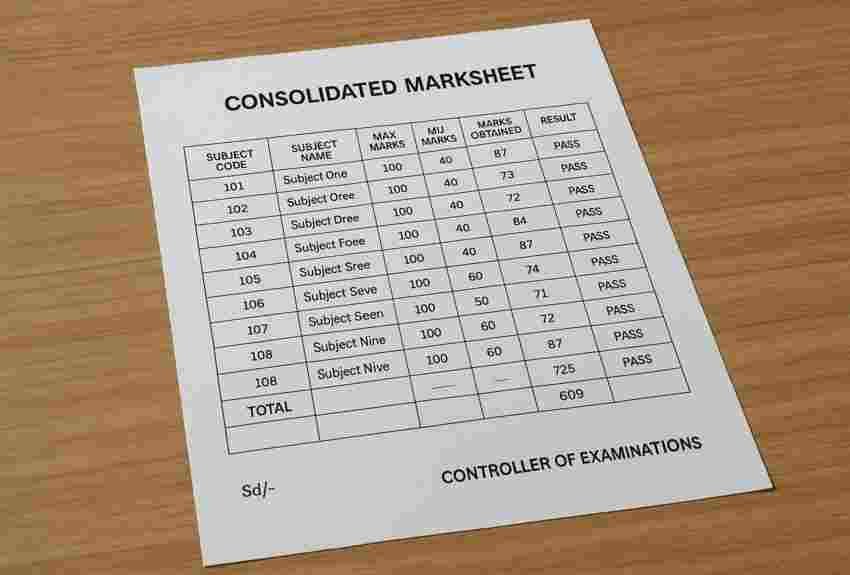
When applying for higher education or jobs, one document that often raises questions is the consolidated marksheet. Students usually receive semester wise or year wise marksheets during their course. But at the end of the program, the university issues a consolidated marksheet that combines everything into one.
This guide will explain the meaning of a consolidated marksheet, its types, format, importance and how it differs from other academic documents.
What is a Consolidated Marksheet?
A consolidated marksheet is an official document issued by a university or college that presents a student’s complete academic record for the entire course in a single sheet. Unlike semester wise marksheets, it shows the overall grades, credits and final results in one place.
- Acts as a summary of all semesters/years.
- Includes subject names, credits, marks/grades and overall GPA/percentage.
- Issued only after the completion of the program (eg, Bachelor’s, Master’s and Diploma).
It is often used as a ready reference for higher studies, government exams, and job applications since it saves students from submitting multiple marksheets.
Types of Consolidated Marksheet
Different institutions may issue different kinds of consolidated marksheets depending on the course:
- Semester-Wise Consolidated Marksheet
- Combines all semester scores into a single sheet.
- Displays SGPA (Semester Grade Point Average) and final CGPA.
- Year-Wise Consolidated Marksheet
- Used by universities that follow an annual examination system.
- Summarises yearly marks and final percentage.
- Course Completion Consolidated Marksheet
- Issued after graduation or completion of a diploma.
- Shows final cumulative performance across the entire course.
- Provisional Consolidated Marksheet
- A temporary version issued before the final degree is awarded.
- Useful for applying to jobs or higher education while awaiting the official degree.
Format of a Consolidated Marksheet
While formats differ across institutions, most consolidated marksheets include the following details:
- Student’s name and roll number
- College/university name and logo
- Course name (eg, B.A., B.Sc., B.Tech and MBA)
- Year of passing and duration of the course
- List of subjects with credits and grades/marks
- SGPA/CGPA or overall percentage
- Division/class (First Class, Distinction, etc.)
- Registrar/Controller of Examinations seal and signature
Example Table Format
| Semester | Subjects | Credits | Grade Points | SGPA |
| Sem 1 | 6 | 24 | 180 | 7.5 |
| Sem 2 | 5 | 20 | 170 | 8.5 |
| … | … | … | … | … |
| Final | – | 140 | 1120 | 8.0 (CGPA) |
Importance of a Consolidated Marksheet
- Single reference document – Eliminates the need to carry multiple semester marksheets.
- Essential for higher education – Universities abroad often ask for consolidated transcripts.
- Job applications – Recruiters may require a consolidated version for quick evaluation.
- Official proof of academic record – Validates that you have completed all required subjects.
- Supports credential evaluation – Agencies like WES use it for converting grades internationally.
Difference Between Consolidated Marksheet and Transcript
| Feature | Consolidated Marksheet | Transcript |
| Scope | Summarises all results in one document | Detailed record of each semester/subject |
| Purpose | Used for local verification, job, or higher education | Required for study abroad, credential evaluation |
| Issued By | University/College | University (official sealed document) |
| Details Included | Overall marks, SGPA, CGPA, class/division | Individual subject grades, credits, GPA |
How to Apply for a Consolidated Marksheet?
If you haven’t received your consolidated marksheet after completing your course, you can apply through your college or university’s examination or registrar office.
Steps:
- Fill out the application form for consolidated marksheet.
- Attach necessary documents (ID proof, course completion certificate, semester marksheets).
- Pay the application fee (varies from ₹200 to ₹1000 in most Indian universities).
- Receive the document either in person or by post.
Conclusion
A consolidated marksheet is one of the most important academic documents you will need after completing your degree. It acts as a summary of your entire performance, combining semester wise details into one official record. For jobs, government exams and especially study abroad applications, a consolidated marksheet is often required alongside transcripts and degree certificates.
Understanding its meaning, types, and format helps students prepare better and avoid confusion when universities or employers request it.
Frequently Asked Questions
1. What is a consolidated marksheet?
It is a single document showing the overall performance of a student across all semesters or years of a course.
2. Is a consolidated marksheet the same as a transcript?
No. A consolidated marksheet is a summary, while a transcript gives detailed subject-wise records with credits.
3. Who issues the consolidated marksheet?
It is issued by the university or college after completion of the degree.
4. Can I use a consolidated marksheet for study abroad?
Yes, but most foreign universities also require official transcripts.
5. How do I get my consolidated marksheet?
Apply at your university’s examination office with required documents and fees.
6. Does a consolidated marksheet include SGPA/CGPA?
Yes, it usually includes SGPA for each semester and final CGPA or percentage.
7. Is a consolidated marksheet mandatory for jobs?
Many recruiters ask for it as a single reference document, though semester marksheets may also be needed.
8. What if I lose my consolidated marksheet?
You can apply for a duplicate copy at your university with an affidavit and fee.
9. Is a provisional consolidated marksheet valid?
Yes, it can be used until the final consolidated marksheet or degree is issued.
10. Do all universities issue consolidated marksheets?
Yes, most universities in India and abroad provide them after course completion.
